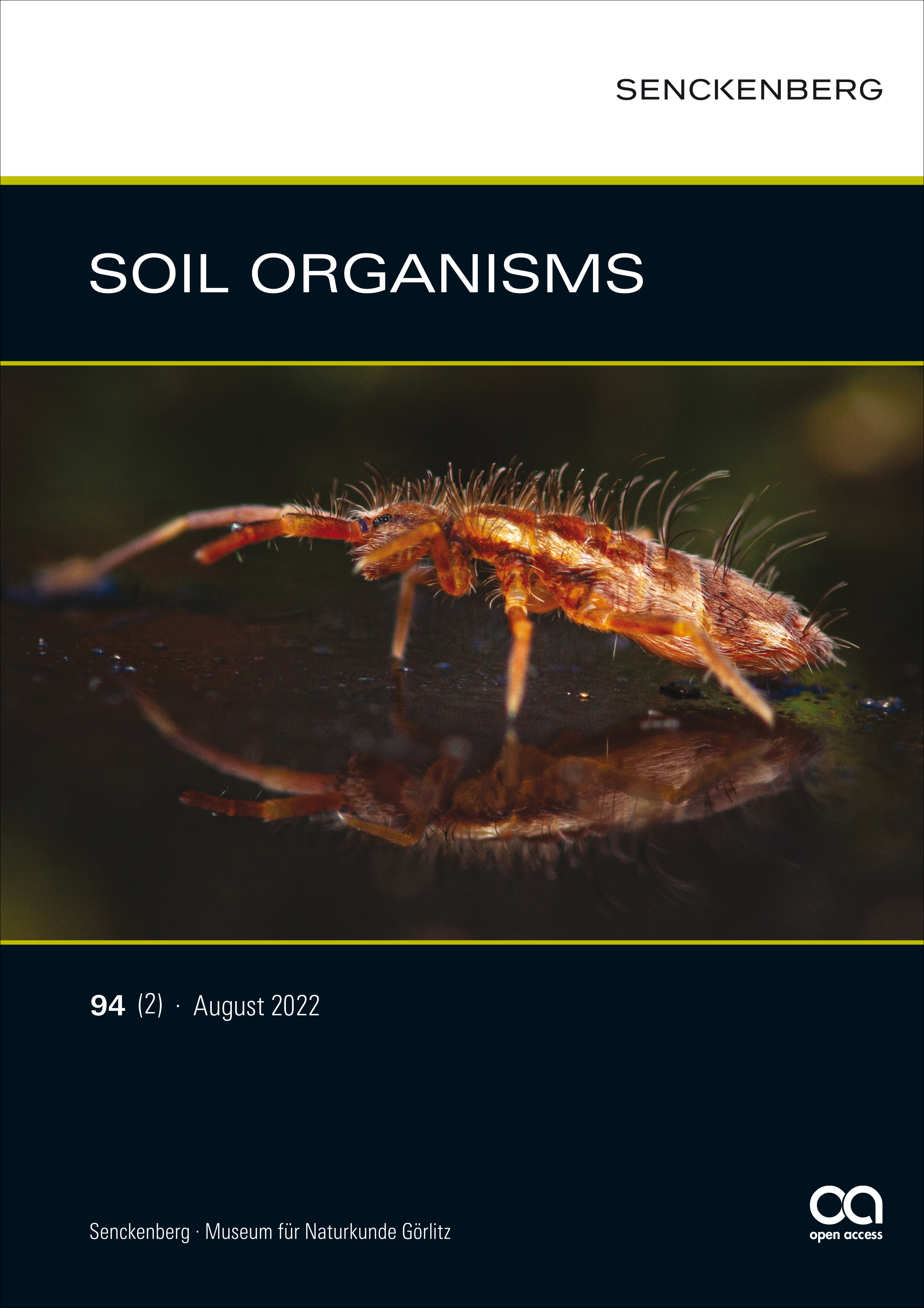Five new records of soil scale insects (Hemiptera: Coccomorpha) for Indonesia
DOI:
https://doi.org/10.25674/so94iss2id183Keywords:
Oriental region, Sternorrhyncha, NeococcoideaAbstract
Information about soil scale insect (Hemiptera: Coccomorpha) diversity, although fragmented, had been progressively improved for Asia, especially in the southern countries such as Indonesia. Recent works recorded 365 species in the country, 21 of which in below ground habit. In this paper, we contribute to the knowledge of Indonesian scale insect diversity by analyzing specimens collected from rainforest, rubber and oil palm plantations in the Province of Jambi and Sumatra, Indonesia. The results include the new records of Rhizoecus americanus, Rhizoecus omphalius, Ripersiella bacorum, Ripersiella cryphia and Ripersiella sabahica (Rhizoecidae) with description of new intraspecific variations. Pseudococcus saccharicola (Pseudococcidae), Geococcus coffeae, and Rhizoecus pignerator (Rhizoecidae) were also collected in this study. With these species, the known Indonesian scale insect fauna increases to 370 species.
Downloads
References
Cayuela, M. L., J. Clause, J. Frouz & P. C. Baveye (2020): Editorial: Interactive feedbacks between soil fauna and soil processes. – Frontiers in Environmental Science 8: 14 [https://doi.org/10.3389/fenvs.2020.00014].
Cox, J. M. (1989): The mealybugs genus Planococcus (Homoptera: Pseudococcidae). – Bulletin of the British Museum (Natural History) 58: 1–78.
Drescher, J., K. Rembold, K. Allen, P. Beckschäfer, D. Buchori, Y. Clough, H. Faust, A. M. Fauzi, D. Gunawan, D. Hertel, et al. (2016): Ecological and socio-economic functions across tropical land use systems after rainforest conversion. – Philosophical Transactions of the Royal Society B: Biological Sciences 371: 20150275 [https://doi.org/10.1098/rstb.2015.0275]
García Morales, M., B. Denno, D. R. Miller, G. L. Miller, Y. Ben-Dov & N. B. Hardy (2016): ScaleNet: A literature-based model of scale insect biology and systematics. – Database 1–5 [https://doi.org/10.1093/database/bav118].
Granara de Willink, M. C. & P. González (2018): Revisión taxonómica de Pseudococcus Westwood (Hemiptera: Pseudococcidae) de Centro y Sudamérica con descripciones de especies nuevas. – Insecta Mundi 0673: 1–117.
Hambleton, E. J. (1946): Studies of hypogeic mealybugs. – Revista de Entomologia. Rio de Janeiro 17: 1–77.
Hambleton, E. J. (1976): A revision of the New World mealybugs of the genus Rhizoecus (Homoptera: Pseudococcidae). – United States Department of Agriculture Technical Bulletin 1522: 1–88.
Jansen, M. G. (2008): A new species of the genus Ripersiella Tinsley (Hemiptera: Coccoidea: Pseudococcidae) from import interceptions in The Netherlands. – ISA Press Lisbon, Oeiras, Portugal, Proceedings of the XI International Symposium on Scale Insect Studies: 322
Kaydan, M. B., Z. Konczné Benedicty, T. Kondo, A. A. Ramos-Portilla & É. Szita (2019): Investigations on the genus Rhizoecus (Hemiptera: Rhizoecidae) with description of two new species from South America. Neotropical Entomology 48: 809–821 [https://doi.org/10.1007/s13744-019-00681-w].
Kozár, F. & Z. Konczné Benedicty (2007): Rhizoecinae of the World. – Hungrian Academy of Science, Budapest. Plant Protection Institute, 1st ed. .
Potapov, A., D. Sandmann & S. Scheu (2019): Ecotaxonomy virtual research environment – traits and species [http://ecotaxonomy.org].
Potapov, A., I. Schaefer, M. Jochum, R. Widyastuti, N. Eisenhauer & S. Scheu (2021): Oil palm and rubber expansion facilitates earthworm invasion in Indonesia. – Biological Invasions 23: 2783–2795 [https://doi.org/10.1007/s10530-021-02539-y].
Russo, A. & G. Mazzeo (1992): Rhizoecus americanus (Hambleton) e Pseudaulacaspis cockerelli (Cooley) (Homoptera Coccoidea) dannosi alle piante ornamentali in Italia. – Bollettino di Zoologia Agraria e di Bachicoltura 24: 215–221.
Sirisena, U. G., G. W. Watson, K. S. Hemachandra & H. N. Wijayagunasekara (2013): A modified technique for the preparation of specimens of Sternorrhyncha for taxonomic studies. Tropical Agricultural Research 24: 139–149.
Takahashi, R. (1928): Coccidae of Formosa. – Philippine Journal of Science 36: 327–347.
Williams, D. J. (1958): Mealybugs (Pseudococcidae: Homoptera) described by W. M. Maskell, R. Newstead, T. D. A. Cockerell and E. E. Green from the Ethiopian region. – Bulletin of the British Museum (Natural History) 6: 205–236.
Williams, D. J. (1969): A revision of the genus Geococcus Green (Homoptera, Coccoidea, Pseudococcidae). – Bulletin of Entomological Research 59: 505–517.
Williams, D. J. (1970): The mealybugs (Homoptera, Coccoidea, Pseudococcidae) of sugar-cane, rice and sorghum. – Bulletin of Entomological Research 60: 109–188 [https://doi.org/10.1017/S0007485300034209].
Williams, D. J. (1996): Four relative species of root mealybugs of the genus Rhizoecus from east and southeast Asia of importance at quarantine inspection (Hemiptera: Coccoidae: Pseudococcidae). – Journal of Natural History 30: 1391–1403.
Williams, D. J. (1998): Mealybugs of the genera Eumyrmococcus Silvestri and Xenococcus Silvestri associated with the ant genus Acropyga Roger and a review of the subfamily Rhizoecinae (Hemiptera, Coccidae, Pseudococcidae). – Bulletin of the British Museum (Natural History) 67: 1–152.
Williams, D. J. (2004): Mealybugs of southern Asia. – Lumpu, The Natural History Museum Kuala Lumpur: Southdene SDN. BHD.
Williams, D. J. & M. C. Granara de Willink (1992): Mealybugs of Central and South America. – 1st ed. CAB International, London, UK.
Zarkani, A., D. Apriyanto, F. Turanli, C. Ercan & M. B. Kaydan (2021): A checklist of Indonesian scale insects (Hemiptera: Coccomorpha). – Zootaxa 5016: 151–195 [https://doi.org/10.11646/zootaxa.5016.2.1].
Downloads
Published
Issue
Section
License
Copyright (c) 2022 SOIL ORGANISMS

This work is licensed under a Creative Commons Attribution 4.0 International License.
Soil Organisms is committed to fair open access publishing. All articles are available online without publication fees. Articles published from Vol. 96 No. 3 (2024) onwards are licensed under the Creative Commons Attribution 4.0 International (CC BY 4.0) license. Articles published from Vol. 80 No. 1 through Vol. 96 No. 2 are available under the previous terms, allowing non-commercial, private, and scientific use.





